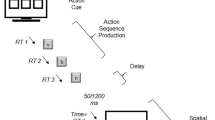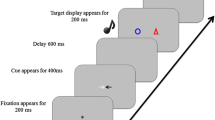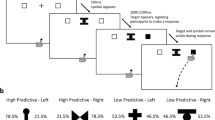Abstract
The degree of preparation of a motor response varies with the information available regarding the response that will need to be executed and with the time provided to process that information. In experiment 1 we investigated the time-course of processing the information specified by discrete spatial cues regarding the upcoming target of directed movements. For this purpose we varied the number of cues that indicated the possible locations of the target and the duration of the cue period preceding the target. The results showed that the effects of processing the information provided by the cues developed progressively and stabilized after 0.2 s. In addition, the level of motor preparation reached was a function of number of cues. However, the effect of number of cues occurred even in the no cue period condition, i.e. when subjects could not have benefited from the information provided by the cues to prepare the response. Further analyses suggested the hypothesis that, in the no cue period condition, the effect of number of cues resulted from the cues acting as distractors (i.e., interference) whereas, with longer cue periods, the effect resulted from the motor preparatory process (i.e., facilitation). This hypothesis was tested in experiment 2 where the number of cues and the number of distractors were varied inversely. Cues and distractors were the same type of stimuli and differed only in their relation to the time of presentation of the target. Subjects performed in a directed response task and in a control detection task. It was predicted that the facilitatory effect of the cues and the interference effect of the distractors on the planning of the directed response would oppose each other and produce a non-monotonic change of RT across conditions. The results conformed to the prediction and, therefore, supported the hypothesis of independent effects of facilitation and interference. In addition, we found that the pattern of RT across conditions in the detection task differed radically with that in the directed response task. This result indicates that the time-dependent effects of cues and distractors are contingent on the type of motor response required in the task, and, in particular on the spatial requirement on the motor response.








Similar content being viewed by others
References
Adam JJ, Pratt J (2004) Dissociating visual attention and effector selection in spatial precuing tasks. J Exp Psychol Hum Percept Perform 30:1092–1106
Alexander GE (1987) Selective neuronal discharge in monkey putamen reflects intended direction of planned limb movements. Exp Brain Res 67:623–634
Atkeson CG, Hollerbach JM (1985) Kinematic features of unrestrained vertical arm movements. J Neurosci 5:2318–2330
Basso MA, Wurtz RH (1998) Modulation of neuronal activity in superior colliculus by changes of target probability. J Neurosci 15:7519–7534
Battaglia-Mayer A, Ferraina S, Marconi B, Bullis JB, Lacquaniti F, Burnod Y, Baraduc P, Caminiti R (1998) Early motor influences on visuomotor transformations for reaching: a positive image of optic ataxia. Exp Brain Res 123:172–189
Bock O, Arnold K (1992) Motor control prior to movement onset: preparatory mechanisms for pointing at visual targets. Exp Brain Res 90:209–216
Bock O, Eversheim U (2000) The mechanisms of movement preparation: a precuing study. Behav Brain Res 108:85–90
Castiello U (2001) The effects of abrupt onsets of 2-D and 3-D distractors on prehension movements. Percept Psychophys 63:1014–1025
Cisek P, Kalaska JF (2005) Neural correlates of reaching decisions in dorsal premotor cortex: specification of multiple direction choices and final selection of action. Neuron 45:801–814
Corneil BD, Munoz DP (1996) The influence of auditory and visual distractors on human orienting gaze shifts. J Neurosci 16:8193–8207
Crawford TJ, Muller HJ (1992) Spatial and temporal effects of spatial attention on human saccadic eye movements. Vis Res 32:293–304
Dassonville P, Lewis SM, Foster HE, Ashe J (1999) Choice and stimulus-response compatibility affect duration of response selection. Cogn Brain Res 7:235–240
Dum RP, Strick PL (2002) Motor areas in the frontal lobe of the primate. Physiol Behav 77:677–682
Favilla M (1997) Reaching movements: concurrency of continuous and discrete programming. Neuroreport 22:3973–3977
Ghez C, Favilla M, Ghilardi MF, Gordon J, Bermejo R, Pullman S (1997) Discrete and continuous planning of hand movements and isometric force trajectories. Exp Brain Res 115:217–233
Hodgson TL, Muller HJ, O’Leary MJ (1999) Attentional localization prior to simple and directed manual responses. Percept Psychophys 61:308–321
Jaeger D, Gilman S, Aldridge JW (1993) Primate basal ganglia activity in a precued reaching task: preparation for movement. Exp Brain Res 95:51–64
Miller J, Riehle A, Requin J (1992) Effects of preliminary perceptual output on neuronal activity of the primary motor cortex. J Exp Psychol Hum Percept Perform 18:1121–1138
Pellizzer G, Hedges JH (2003) Motor planning: effect of directional uncertainty with discrete spatial cues. Exp Brain Res 150:276–289
Pellizzer G, Hedges JH (2004) Motor planning: effect of directional uncertainty with continuous spatial cues. Exp Brain Res 154:121–126
Prut Y, Fetz EE (1999) Primate spinal interneurons show pre-movement instructed delay activity. Nature 401:590–594
Ratcliff R (1993) Methods for dealing with reaction time outliers. Psychol Bull 114:510–532
Remington RW, Johnston JC, Yantis S (1992) Involuntary attentional capture by abrupt onsets. Percept Psychophys 51:279–290
Riehle A, Requin J (1995) Neuronal correlates of the specification of movement direction and force in four cortical areas of the monkey. Behav Brain Res 70:1–13
Riggio L, Bello A, Umiltà C (1998) Inhibitory and facilitatory effects of cue onset and offset. Psychol Res 61:107:118
Rosenbaum DA (1980) Human movement initiation: specification of arm, direction, and extent. J Exp Psychol: General 109:444–474
Rutherford A (2001) Introducing ANOVA and ANCOVA. A GLM Approach. Sage, London
Shaw ML (1978) A capacity allocation model for reaction time. J Exp Psychol Hum Percept Perform 4:586–598
Snedecor GW, Cochran WG (1989) Statistical methods, 8th edn. Iowa State University Press, Ames
Acknowledgements
This research was supported by a Merit Review Award from the Medical Research Service of the US Department of Veterans Affairs.
Author information
Authors and Affiliations
Corresponding author
Rights and permissions
About this article
Cite this article
Pellizzer, G., Hedges, J.H. & Villanueva, R.R. Time-dependent effects of discrete spatial cues on the planning of directed movements. Exp Brain Res 172, 22–34 (2006). https://doi.org/10.1007/s00221-005-0317-2
Received:
Accepted:
Published:
Issue Date:
DOI: https://doi.org/10.1007/s00221-005-0317-2




